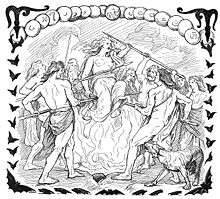Gullveig

In Norse mythology, Gullveig is a being who was speared by the Æsir, burnt three times, and yet thrice reborn. Upon her third rebirth, Gullveig's name becomes Heiðr and she is described as a knowledgeable and skillful völva. Gullveig/Heiðr is solely attested in the Poetic Edda, compiled in the 13th century from earlier traditional material. Scholars have variously proposed that Gullveig/Heiðr is the same figure as the goddess Freyja, that Gullveig's death may have been connected to corruption by way of gold among the Æsir, and/or that Gullveig's treatment by the Æsir may have led to the Æsir-Vanir War.
Etymology
The etymology of the Old Norse name Gullveig is problematic. The first element, Gull-, means "gold", yet the second element, veig, is murky (a situation shared with the Old Norse personal names Rannveig, Sölveig, and Thórveig). Veig may sometimes mean "alcoholic drink", "power, strength", and sometimes also "gold". The name Heiðr (Old Norse "fame", in adjective form "bright, clear") is semantically related; scholar Rudolf Simek comments that although Gullveig's name changes to Heiðr, the meaning still remains basically the same.[1] Heiðr is sometimes anglicized as Heith, Heid, or Heidi.
Attestations
Gullveig is solely attested in the Poetic Edda poem Völuspá. In the poem, a völva recalls that Gullveig was pierced by spears before being burnt three times in the hall of Hárr (Hárr is one of Odin's various names), and yet was three times reborn. The völva says that, presumably after Gullveig's burning, she was called Heiðr and that Heiðr was a knowledgeable völva who could perform great feats:
Benjamin Thorpe translation:
- She that remembers, the first on earth,
- when Gullveig they with lances pierced,
- and in the high one's hall her burnt,
- thrice burnt, thrice brought forth,
- oft not seldom; yet she still lives.
- Heidi they called her, whitherso'er she came,
- the well-foreseeing Vala:
- wolves she tamed, magic arts she knew, magic arts practiced;
- ever she was the joy of evil people.[2]
Henry Adams Bellows translation:
- The war I remember, the first in the world,
- When the gods with spears had smitten Gollveig,
- And in the hall of Hor had burned her,
- Three times burned, and three times born,
- Oft and again, yet ever she lives.
- Heith they named her who sought their home
- The wide-seeing witch, in magic wise;
- Minds she bewitched that were moved by her magic,
- To evil women a joy she was.[3]
A description of the Æsir–Vanir War follows and the poem continues thereafter.
Theories
Starting with scholar Gabriel Turville-Petre, scholars such as Rudolf Simek and John Lindow have theorized that Gullveig/Heiðr is the same figure as Freyja, and that her involvement with the Æsir somehow led to the events of the Æsir–Vanir War.[4]
See also
- List of names of Freyja, a list of various names attributed to the goddess Freyja
Notes
References
- Bellows, Henry Adams (1923). The Poetic Edda. American-Scandinavian Foundation.
- Lindow, John (2002). Norse Mythology: A Guide to the Gods, Heroes, Rituals, and Beliefs. Oxford University Press. ISBN 0-19-515382-0
- Orchard, Andy (1997). Dictionary of Norse Myth and Legend. Cassell. ISBN 0-304-34520-2
- Thorpe, Benjamin (Trans) (1907). Edda Sæmundar Hinns Frôða The Edda of Sæmund the Learned. Part I. London Trübner & Co.
- Simek, Rudolf (2007) translated by Angela Hall. Dictionary of Northern Mythology. D.S. Brewer. ISBN 0-85991-513-1